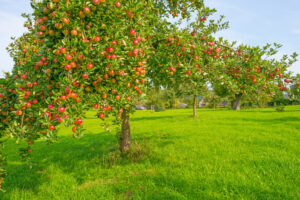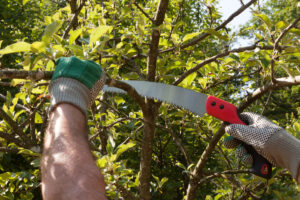Introduction

I have always wanted an apple tree. Sadly where I live they don’t do well as we don’t get enough chilling hours and the humidity and heat can sometimes do them in. So when we bought our homestead property in zone 7a I thought here’s my opportunity to try my hand at growing a small homestead orchard and apple trees were the first fruit tree I planted. I researched extensively how to grow apple trees.
Now my soil, what little I have over the bedrock was cleared forest before we built. I had no reason to think trees could not grow there given that, but my builder did tell me no basement unless you want to use dynamite! So I knew my soil was not deep. Still, with a hopeful heart, I started to research how to grow apple trees.
Choosing the right type of apple was the first step in my journey to establish a small home orchard. The world of apple varieties was as fascinating as it was overwhelming, each with its unique characteristics and needs. It became crucial for me to select a variety that would thrive in the climate and soil of my zone 7a property. Just like finding a home, it was all about location, location, location. Given the forest-like conditions, I was optimistic but mindful of the builder’s dynamite warning! I dove deep into research, hopeful and eager to plant the apple tree that would flourish in my land’s unique conditions.
Picking the Right Apple Tree
After searching for months, I was able to narrow down my choices to a few varieties that were both successful in zone 7a and could tolerate my shallow soil. With some luck, I settled on the pink lady apple tree and an Arkansas black. These two cultivars serve as pollinators for each other. If you want fruit you have to plant two that will pollinate each other, Now, it was time to get down to business and tackle the various tasks that come with establishing an orchard.
There are many different varieties of apples available, each with their own flavor and texture. Depending on what you are looking for, some may be better suited to your needs than others. For instance, tart apples such as Granny Smiths are great for baking and cooking with while sweeter varieties like Honeycrisps are perfect for eating fresh. Doing a bit of research into the different apple varieties can help you determine which type will best suit your tastes and needs!
For an added source of inspiration, it is also a good idea to visit other apple orchards in your area. Seeing how others have managed their trees can be very beneficial when planning out the layout and caring for your orchard. Additionally, many orchards offer workshops and seminars on various aspects of apple tree care that can give you valuable insight into the proper techniques. With a little bit of knowledge and effort, you can have your apple orchard in no time!
Picking the Right Site for Your Apple Tree
The first step was selecting the right site for my apple trees. Apple trees need 6 hours of sunshine to do well at producing fruit. They also need regular water. This could be a problem depending on your situation. Also, we did not live full-time at what we hoped would be our retirement home. I solved this with the watering ring.
The thing to remember about these is they must be in touch with the soil to “recharge” when it rains. You can’t have them on top of the cardboard, landscaping fabric or mulch. They won’t recharge. Also if you have a long dry spell you will have to recharge by soaking in water for several hours which makes them somewhat heavy.
You also have to consider your mutually pollinating apple trees need to be within a 100-foot range of each other to cross-pollinate. It’s also helpful if you have pollinator-attracting plants beside your apple trees to attract bees and other pollinators
My long-term plan is to add beehives to my homestead both because I am interested in keeping bees which are threatened species and because it will help with pollination.
This is a good series of books. I own several. It is an affiliate link.
Preparing the Soil, Planting and Caring for the Young Apple Tree
The next step was to plant the tree! I made sure to dig a wide enough hole that would accommodate the roots of my apple tree and keep them from growing too close to the surface. It’s recommended to dig the hole twice the size of the pot and just as deep. I actually dug deeper because I wanted to add amendments. I added plenty of organic matter such as compost to help enrich the soil around the roots and reduce compaction. I also added a stake for extra support as my apple trees grew taller. To top it off, I applied a layer of mulch to help conserve moisture in the soil and suppress weed growth. One thing to remember, remove the tag that comes wrapped around your trees trunk. If you forget it will eventually girdle and kill your tree.
Apple trees prefer a Ph somewhere between 6.5 and 7 so a little on the acid side. Most soils fall in this range. Check your soil and amend with lime if needed.
As my apple tree started to grow, so did my excitement! I could imagine the juicy red apples that were sure to come with time. With the proper care and nutrients, my apple trees were guaranteed success in my zone 7a orchard oasis!
The key to success included lots of sun, frequent deep watering and fertilizing. I applied fertilizer several times throughout the year from spring until early fall.
Pruning your Apple Tree

Now that I had a strong foundation for my apple tree, I started looking into ways to maximize its yield. This included understanding how pruning can help improve air circulation and sunlight penetration within the canopy of the tree. The best time to prune an apple tree is in late winter while it is dormant. Pruning requires sharp tools and some general rules should be followed to ensure your apple tree has an attractive shape and maximum productivity.
Start by removing any dead, diseased or crisscrossed branches then thin out the canopy. This will help light reach all parts of the tree and reduce competition for resources among the branches. Make sure to not remove too much of the tree’s canopy as this can weaken its overall health and reduce fruiting potential.
You also have to prune apple trees that are bearing, if they have too many apples on the branch. The weight can break the branch and pruning off some of the apples makes the ones left bigger!
After pruning, it is also important to protect your apple trees from pests and disease. Utilize a combination of organic sprays and integrated pest management techniques to ensure your orchard is safe from unwanted critters. This will help maximize the potential of your apple tree for years to come!
Apple Tree Pest Management
Apple tree pest management techniques should include regularly inspecting the foliage for signs of pest damage, as well as trapping and collecting any insects found in the orchard. It is also important to use barrier methods such as fencing and netting to keep wildlife away from your trees. Finally, applying organic mulch around the tree will help retain moisture and suppress weed growth.
Common pests that affect apple trees include aphids, apple maggot flies, and codling moths. Aphids are small, soft-bodied insects that suck the sap out of the apple tree, causing curled and yellowed leaves. A strong stream of water or application of insecticidal soap can effectively manage an aphid population.
Apple maggots lay eggs in the apple, and the resulting larvae feed on the fruit, making it inedible. Trapping adult flies with red ball traps can be an effective control method.
Codling moths are another pest that targets apple trees. The larvae burrow into the apple, making it unfit for consumption. To control codling moths, apply a codling moth pheromone to confuse male moths and prevent them from finding females to mate with.
Organic pest management options include using beneficial insects, soil amendments and organic sprays. Beneficial insects such as ladybugs and lacewings can help keep your apple trees pest-free by providing natural predation. Soil amendments like compost or manure can also help improve the overall health of your tree and make it more resistant to infection. Organic sprays containing neem oil can be used to effectively control specific pests if necessary.
Integrated pest management is a comprehensive approach that combines multiple control methods including cultural controls, natural predators and organic sprays. This approach can help reduce the overall amount of pesticides used while still achieving effective results.
Harvesting Apples
Apple trees vary in how old they need to be to bear fruit. Those on standard rootstock can take 8-10 years. Semi-dwarf and dwarf trees bear fruit in 3-5 years.
When the apples are ripe, you can either pick them yourself or hire a service to do it for you. It’s best to harvest apples early in the morning, as they will be less likely to bruise and spoil. Apples should be handled carefully, as they can easily become damaged if dropped or mishandled.
Once harvested, most apples can be stored for several weeks or even months if kept in the right conditions. Cool temperatures and high humidity are ideal for keeping apples fresh and ripe. You should also check your apples regularly to make sure there are no signs of spoilage or mold. Each variety of apple ripens at different times so be sure to know when yours is ready to pick. Apples should be picked when they are full-size and mature, usually late in the summer or early fall depending on your location. Use a gentle upward pull to remove apples from the tree without damaging it.
Conclusion
Apple trees are an excellent addition to any garden and provide a delicious crop of fruit that you can enjoy year after year. With the right care and attention, you can successfully grow an apple tree of your own and enjoy the fruits of your labor. Taking a little time to make sure that your tree is well cared for can help ensure that it remains healthy and productive for many years to come!
If you are interested and wondering what to do with all your apples you might try your hand at apple wine!
For more on homesteading topics click here.
Happy harvesting!
Resources:
https://www.almanac.com/plant/apples
https://www.gardenersworld.com/how-to/grow-plants/how-to-grow-apples/

